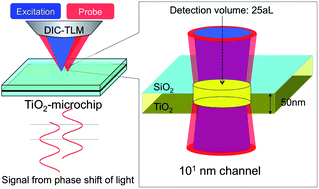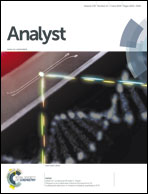Detection of zeptomole quantities of nonfluorescent molecules in a 101 nm nanochannel by thermal lens microscopy
Abstract
Nanofluidics in 101 nm space, whose scale is comparable to the electric double layer (EDL) and the size of biomolecules, promises novel functional analytical devices. However, the detection, which is indispensable to the integrated chemical system, is still challenging in such an ultra-small space. Previously, we reported a differential interference contrast thermal lens microscope (DIC-TLM) based on the photothermal interferometry principle and succeeded in detection of nonfluorescent molecules in 102 nm spaces. However, the thermal diffusion into substrates becomes a problem for detection in 101 nm spaces. The DIC-TLM signals are significantly cancelled out in spaces much smaller than the confocal length (∼102 nm), which makes DIC-TLM detection in 101 nm space quite difficult. To overcome this problem, we propose a new channel structure that benefits the thermal diffusion and sensitivity enhancement in DIC-TLM by employing TiO2 as a substrate material for compensating the signal cancellation effect. As a result, DIC-TLM detection of nonfluorescent molecules (800 molecules) was successfully demonstrated in a nanochannel with a depth of 50 nm. The developed detection method will contribute to the functional nanofluidic devices utilizing 101 nm spaces.


 Please wait while we load your content...
Please wait while we load your content...